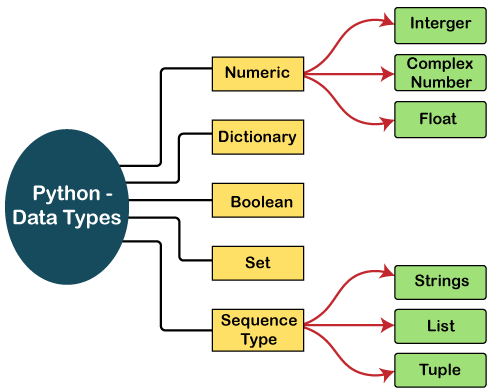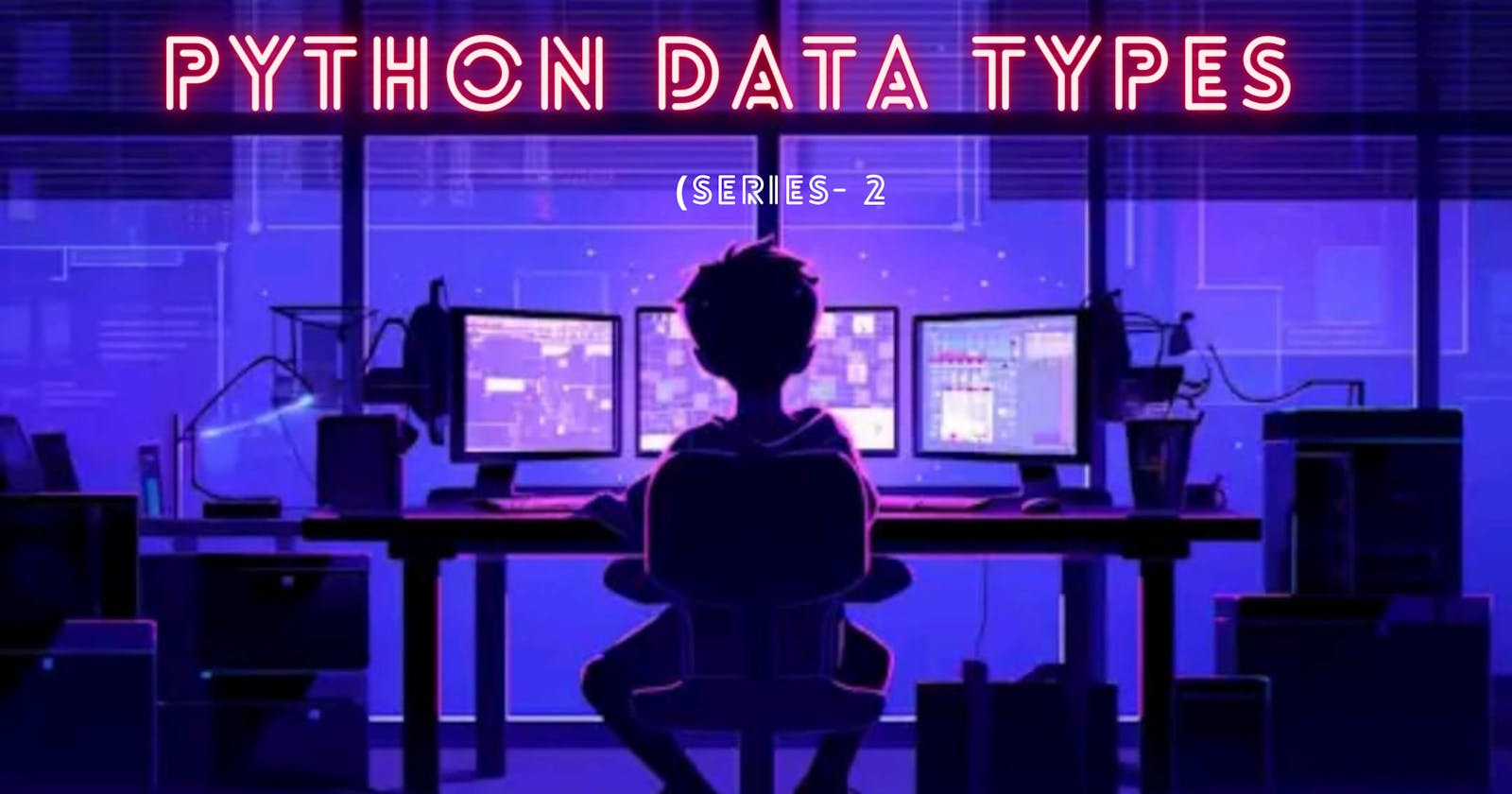Hey techies, I hope and wish u have a good day today, welcome to this week's article. Today, I am going to make you gain knowledge on "data types". If you are new to Python programming then this will help you flaunt your coding skills among your peers. Hope you are loving my articles and I appreciate it if you show a response by commenting, liking or even sharing on your socials. I am focusing more on Python so I also suggest you to read my previous articles on Python.

List of data types:
Number
Dictionary
Set
Boolean
Sequence
"""ALL THESE ARE DIFFERENT TYPES OF SPELLS WE NEED ,LETS Goo..."""
1. Number
Number stores numeric values. The integer, float, and complex values belong to a Python Numbers data-type. Python provides the type() function to know the data-type of the variable. Similarly, the isinstance() function is used to check an object belongs to a particular class.
a = 5
print("The type of a", type(a))
b = 40.5
print("The type of b", type(b))
c = 1+3j
print("The type of c", type(c))
print(" c is a complex number", isinstance(1+3j,complex))
Output:
The type of a <class 'int'>
The type of b <class 'float'>
The type of c <class 'complex'>
c is complex number: True
Python supports three types of numeric data.
Int - Integer value can be any length such as integers 10, 2, 29, -20, -150 etc. Python has no restriction on the length of an integer. Its value belongs to int
Float - Float is used to store floating-point numbers like 1.9, 9.902, 15.2, etc. It is accurate up to 15 decimal points.
complex - A complex number contains an ordered pair, i.e., x + iy where x and y denote the real and imaginary parts, respectively. The complex numbers like 2.14j, 2.0 + 2.3j, etc.
2.Sequence Type
The string can be defined as the sequence of characters represented in the quotation marks. In Python, we can use single, double, or triple quotes to define a string.
In the case of string handling, the operator + is used to concatenate two strings as the operation "hello"+" python" returns "hello python".
The operator is known as a repetition operator as the operation "Python" 2 returns 'Python Python'.
String handling in Python is a straightforward task since Python provides built-in functions and operators to perform operations in the string.
String
str = "string using double quotes"
print(str)
s = '''''A multiline
string'''
print(s)
Output:
string using double quotes
A multiline
string
Consider the following example of string handling.
Example - 2
str1 = 'hello javatpoint' #string str1
str2 = ' how are you' #string str2
"""we can do slicing in string like this"""
print (str1[0:2]) #printing first two character using slice operator
print (str1[4]) #printing 4th character of the string
print (str1*2) #printing the string twice
print (str1 + str2) #printing the concatenation of str1 and str2
Output:
he
o
hello javatpointhello javatpoint
hello javatpoint how are you
3. List(mutable)
Python Lists are similar to arrays in C. However, the list can contain data of different types. The items stored in the list are separated with a comma (,) and enclosed within square brackets [].
We can use slice [:] operators to access the data of the list.
We can add(+) and multiply (*) the list in the same way we have done for strings.
list1 = [1, "hi", "Python", 2]
#Checking type of given list
print(type(list1))
#Printing the list1
print (list1)
# List slicing
print (list1[3:])
# List slicing
print (list1[0:2])
# List Concatenation using + operator
print (list1 + list1)
# List repetation using * operator
print (list1 * 3)
Output:
[1, 'hi', 'Python', 2]
[2]
[1, 'hi']
[1, 'hi', 'Python', 2, 1, 'hi', 'Python', 2]
[1, 'hi', 'Python', 2, 1, 'hi', 'Python', 2, 1, 'hi', 'Python', 2]
4. Tuple(un-mutable)
A tuple is similar to the list in many ways. Like lists, tuples also contain the collection of the items of different data types. The items of the tuple are separated with a comma (,) and enclosed in parentheses ().
- A tuple is a read-only data structure as we can't modify the size and value of the items of a tuple.
tup = ("hi", "Python", 2)
# Checking type of tup
print (type(tup))
#Printing the tuple
print (tup)
# Tuple slicing
print (tup[1:])
print (tup[0:1])
# Tuple concatenation using + operator
print (tup + tup)
# Tuple repatation using * operator
print (tup * 3)
# Its un-mutale it cant be changed once it is given so,adding value to tup. It will throw an error.
t[2] = "hi"
Output:
<class 'tuple'>
('hi', 'Python', 2)
('Python', 2)
('hi',)
('hi', 'Python', 2, 'hi', 'Python', 2)
('hi', 'Python', 2, 'hi', 'Python', 2, 'hi', 'Python', 2)
Traceback (most recent call last):
File "main.py", line 14, in <module>
t[2] = "hi";
TypeError: 'tuple' object does not support item assignment.
5.Dictionary(mutable)
Dictionary is an unordered set of a key-value pair of items. It is like an associative array or a hash table where each key stores a specific value. Key can hold any primitive data type, whereas value is an arbitrary Python object.
The items in the dictionary are separated with the comma (,) and enclosed in the curly braces {}.
Dictionaries themselves are mutable, so entries can be added, removed, and changed at any time.
d = {1:'Jimmy', 2:'Alex', 3:'john', 4:'mike'}
# Printing dictionary
print (d)
# Accesing value using keys
print("1st name is "+d[1])
print("2nd name is "+ d[4])
print (d.keys())
print (d.values())
Output:
{1: 'Jimmy', 2: 'Alex', 3: 'john', 4: 'mike'}
1st name is Jimmy
2nd name is mike
dict_keys([1, 2, 3, 4])
dict_values(['Jimmy', 'Alex', 'john', 'mike'])
6.Boolean
Boolean type provides two built-in values, True and False. These values are used to determine the given statement true or false.
It denotes by the class bool.
True can be represented by any non-zero value or 'T'.
whereas false can be represented by the 0 or 'F'.
Consider the following example.
# Python program to check the boolean type
print(type(True))
print(type(False))
a = 1
b = -67
print(bool(a))
print(bool(b))
"""it returns true because both are non zero integers"""
a1=0
b1 = ()#empty inside means zero[0]
print(bool(a1))
print(bool(b1))
Output:
<class 'bool'>
<class 'bool'>
True
True
False
False
7.Set(mutable)
Python Set is the unordered collection of the data type,It is iterable, mutable(can modify after creation), and has unique elements. In set, the order of the elements is undefined; it may return the changed sequence of the element. The set is created by using a built-in function set(), or a sequence of elements is passed in the curly braces and separated by the comma. It can contain various types of values.
Similar to that of "Dictionary"
It is iterable, mutable(can modify after creation), and has unique elements.
The set is created by using a built-in function set(), or a sequence of elements is passed in the curly braces and separated by the comma.
Set themselves are mutable, so entries can be added, removed, and changed at any time.
# Creating Empty set set1 = set() set2 = {'James', 2, 3,'Python'} #Printing Set value print(set2) # Adding element to the set set2.add(10) print(set2) #Removing element from the set set2.remove(2) print(set2) Output: {3, 'Python', 'James', 2} {'Python', 'James', 3, 2, 10} {'Python', 'James', 3, 10}
Yeah thats for today hope u will utilize it💡 ,lets meet in the next blog Cyaaa🤫"
Quote of the day
Almost everything will work if you unplug it for a few minutes...including you.
